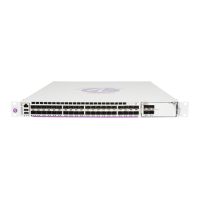Interface Configuration
7750 SR Interface Configuration Guide Page 345
queue-group
Syntax queue-group queue-group-name instance instance-id
no queue-group
Context config>port>ethernet>network>egress
Description This command is used to create a queue-group instance in the network egress context of a port.
Queue-groups containing queues only or policers and queues can be instantiated. When a port is a LAG, one
instance of the queue-group is instantiated on each member link.
One or more instances of the same queue-group name and/or a different queue-group name can be created in
the network egress context of a port.
The queue-group-name must be unique within all network egress and access egress queue groups in the sys-
tem. The queue-group instance-id must be unique within the context of the port.
The no version of this command deletes the queue-group instance from the network egress context of the
port.
Parameters queue-group-name — Specifies the name of the queue group template up to 32 characters in length.
instance instance-id — Specifies the identication of a specific instance of the queue-group.
Values 1—40960
xgig
Syntax xgig {lan |wan}
Context config>port>ethernet
Description This command configures a 10 Gbps interface to be in Local or Wide Area Network (LAN or WAN) mode.
When configuring the port to be in WAN mode, you can change certain SONET/SDH parameters to reflect
the SONET/SDH requirements for this port. When you configure a port for LAN mode, all SONET/SDH
parameters are pre-determined and not configurable.
Default lan
Parameters lan — Sets the port to operate in LAN mode.
wan — Sets the port to operate in WAN mode.
otu
Syntax [no] otu
Context config>port
Description This command specifies whether or not to enable the OTU encapsulation type (encapsulated 10GE-LAN/
WAN or OC192). The port must be shut down before OTU is enabled.
